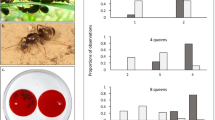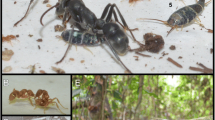Summary
-
1.
Compatibility between workers of 21 different colonies of the acacia-ant Pseudomyrmex ferruginea was examined. The colonies were reared from foundress queens in the greenhouse, on a clone of Acacia hindsii. Widespread incompatibility between colonies was encountered in these tests. Since diet and nesting environment are uniform, these results strongly suggest that the ants are producing recognition pheromones.
-
2.
Worker brood from a stock colony was separated into groups of larvae and pupae, and each group was reared by a different foster reproductive female. The absence of antagonistic reactions between workers reared in the different groups indicates that the reproductive females are not the direct source of colony recognition pheromones.
Similar content being viewed by others
References
Barrows EM, Bell WJ, Michener CD (1975) Individual odor differences and their social functions in insects. Proc Natl Acad Sci USA 72:2824
Fielde AM (1903) artificial mixed nests of ants. Biol Bull (Woods Hole) 5:320
Fielde AM (1904) Power of recognition among ants. Biol Bull (Woods Hole) 7:227
Free JB (1958) The defence of bumblebee colonies. Behaviour 12:233
Greenberg L (1979) Genetic component of bee odor in kin recognition. Science 206:1095
Hölldobler B, Michener CD (1980) Mechanisms of identification and discrimination in social Hymenoptera. In: Markl H (ed) Evolution of social behavior: Hypotheses and empirical tests. (Dahlem Konferenzen 1980). Verlag Chemie, Weinheim
Janzen DH (1966) Coevolution of mutualism between ants and acacias in Central America. Evolution 20:249
Janzen DH (1967) Interaction of a bull's horn acacia (Acacia cornigera) with an ant inhabitant (Pseudomyrmex ferruginea) in eastern Mexico. Univ Kansas Sci Bull 47:315
Janzen DH (1973) Evolution of polygynous obligate acacia-ants in western Mexico. J Anim Ecol 42:727
Kalmus H, Ribbands CR (1952) The origin of the odors by which honeybees distinguish their companions. Proc R Soc 140:50
Wilson EO (1971) The insect societies. Belknap, Harvard, p 548
Author information
Authors and Affiliations
Rights and permissions
About this article
Cite this article
Mintzer, A. Nestmate recognition and incompatibility between colonies of the acacia-ant Pseudomyrmex ferruginea . Behav Ecol Sociobiol 10, 165–168 (1982). https://doi.org/10.1007/BF00299680
Received:
Accepted:
Issue Date:
DOI: https://doi.org/10.1007/BF00299680




